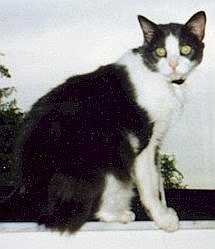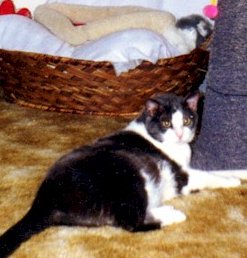My cat is Patches, an 18 year old female gray
and white spayed domestic cat. She was diagnosed shortly before her 10th birthday. So she
has survived with this illness the for 8+ years with only 1 serious episode - the one that
occurred New Year's Eve 1995 and almost cost her life.

Patches in the window.
|
I was returning home from Christmas vacation. I
realized something was not right. I new she was having the "Hypoglycemic"
condition I heard about and had seen only in minor states. I had a 2-1/2 hour drive ahead
of me and didn't know what to do. I stopped at a convenience store to purchase syrup but
she laid in my arms as if dead. Being New Year's Eve night I called the local emergency
animal hospital and they told me to bring her in immediately. When I got there they
were waiting with a stretcher and the whole works. They quickly revived her and
later that night the Vet called and said she was in renal failure and there seemed to be
little hope of a good prognosis.
I then took her to my Vet and he said we had one chance to get her BUN levels back to
normal and that was to give her subcutaneous fluids at home. I learned to administer
fluids at home so she didn't have to go to the vet's and wouldn't be as stressed. I
also had to force feed her as she typically became anorexic. One night I thought she
had died in my arms. I started to give up and wonder if what I was doing was fair to
her. So when I left for work one morning I told her it was OK....that day when I
returned home from work, she was waiting at the door for me. I witnessed a true
miracle. Her levels began to show unbelievable improvement - the Vet could not believe
it! And that was 4+ years ago!!!!
She currently takes 6 units twice a day of Ilentin I NPH (my concern now is that this
insulin has been discontinued). This was the original type insulin and has worked
rather successfully. The dose has altered between 5 to 7 units. In the beginning I was
able to do one injection a day, but the twice a day worked better and reduced her chance
of a hypoglycemic attack. I monitor mostly by watching her water intake and her behavior -
if she was depressed or weak, if she was cleaning herself (I found this to be a positive
sign!), and her litterbox habits. Her diet is Hills prescription AD, KD and WD for
variety. Her weight is good at about 10-11 lbs. and her activity level due to her
age is limited.

Patches in her house.
|
Her hind legs have appeared to be a little weaker but she still gets around
pretty good. Her nails have started to become effected but the Vet assured me it's
more of a fungus and not serious as in human diabetic. In the past she did get sores
around her gums and under her chin but that has been kept under good control and she
doesn't have any now.
Of course her traveling days ended after the 1995 episode and she gets minor hypoglycemic
attacks more often. She seems to know how to keep her blood glucose up by going
directly to the food bowl and eating. When I'm there I give her the Karo which works
well.
I have had her since I was 18 and know the end is sooner rather than later. My own
personal opinion: the best medicine is unconditional love and attention you give the
pet..I believe it is what has sustained Patches life. I think my Vet will agree...he
is amazed by her story.
Contributed by Linda
Patches passed away from cancer on August 24, 1999. You can visit
Linda's tribute to
Patches.
  



Contributed June 1999
Copyright. All rights reserved.
This site is for information purposes only. Please consult
your veterinarian. |
 Patches' Story
Patches' Story Patches' Story
Patches' Story